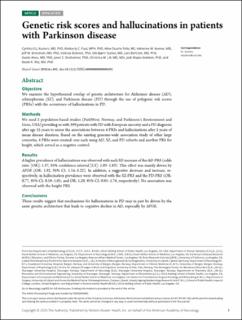| dc.contributor.author | Kusters, Cynthia D.J. | |
| dc.contributor.author | Paul, Kimberly C. | |
| dc.contributor.author | Folle, Aline Duarte | |
| dc.contributor.author | Keener, Adrienne M. | |
| dc.contributor.author | Bronstein, Jeff M. | |
| dc.contributor.author | Dobricic, Valerija | |
| dc.contributor.author | Tysnes, Ole-Bjørn | |
| dc.contributor.author | Bertram, Lars | |
| dc.contributor.author | Alves, Guido Werner | |
| dc.contributor.author | Sinsheimer, Janet S. | |
| dc.contributor.author | Lill, Christina M. | |
| dc.contributor.author | Maple-Grødem, Jodi | |
| dc.contributor.author | Ritz, Beate R. | |
| dc.date.accessioned | 2021-05-21T08:37:59Z | |
| dc.date.available | 2021-05-21T08:37:59Z | |
| dc.date.created | 2020-12-21T12:59:47Z | |
| dc.date.issued | 2020-07 | |
| dc.identifier.citation | Kusters, C. D.J., Paul, K. C.., Folle, A. D. et al. (2020) Genetic risk scores and hallucinations in patients with Parkinson disease. Neurology: Genetics, 6 (5). | en_US |
| dc.identifier.issn | 2376-7839 | |
| dc.identifier.uri | https://hdl.handle.net/11250/2755980 | |
| dc.description.abstract | Objective We examine the hypothesized overlap of genetic architecture for Alzheimer disease (AD), schizophrenia (SZ), and Parkinson disease (PD) through the use of polygenic risk scores (PRSs) with the occurrence of hallucinations in PD.
Methods We used 2 population-based studies (ParkWest, Norway, and Parkinson's Environment and Gene, USA) providing us with 399 patients with PD with European ancestry and a PD diagnosis after age 55 years to assess the associations between 4 PRSs and hallucinations after 5 years of mean disease duration. Based on the existing genome-wide association study of other large consortia, 4 PRSs were created: one each using AD, SZ, and PD cohorts and another PRS for height, which served as a negative control.
Results A higher prevalence of hallucinations was observed with each SD increase of the AD-PRS (odds ratio [OR]: 1.37, 95% confidence interval [CI]: 1.03–1.83). This effect was mainly driven by APOE (OR: 1.92, 95% CI: 1.14–3.22). In addition, a suggestive decrease and increase, respectively, in hallucination prevalence were observed with the SZ-PRS and the PD-PRS (OR: 0.77, 95% CI: 0.59–1.01; and OR: 1.29, 95% CI: 0.95–1.76, respectively). No association was observed with the height PRS.
Conclusions These results suggest that mechanisms for hallucinations in PD may in part be driven by the same genetic architecture that leads to cognitive decline in AD, especially by APOE. | en_US |
| dc.language.iso | eng | en_US |
| dc.publisher | Wolters Kluwer Health, Inc. on behalf of the American Academy of Neurology | en_US |
| dc.rights | Attribution-NonCommercial-NoDerivatives 4.0 Internasjonal | * |
| dc.rights.uri | http://creativecommons.org/licenses/by-nc-nd/4.0/deed.no | * |
| dc.subject | Parkinson | en_US |
| dc.subject | Alzheimer | en_US |
| dc.subject | nevrologi | en_US |
| dc.subject | Schizofreni | en_US |
| dc.subject | hallusinasjoner | en_US |
| dc.subject | genetikk | en_US |
| dc.title | Genetic risk scores and hallucinations in patients with Parkinson disease | en_US |
| dc.type | Peer reviewed | en_US |
| dc.type | Journal article | en_US |
| dc.description.version | publishedVersion | en_US |
| dc.rights.holder | Copyright © 2020 The Author(s) | en_US |
| dc.subject.nsi | VDP::Medisinske Fag: 700::Klinisk medisinske fag: 750::Nevrologi: 752 | en_US |
| dc.source.pagenumber | 9 | en_US |
| dc.source.volume | 6 | en_US |
| dc.source.journal | Neurology: Genetics | en_US |
| dc.source.issue | 5 | en_US |
| dc.identifier.doi | 10.1212/NXG.0000000000000492 | |
| dc.identifier.cristin | 1862368 | |
| cristin.ispublished | true | |
| cristin.fulltext | original | |
| cristin.qualitycode | 1 | |

